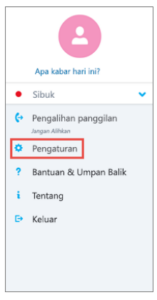Set general options for Android devices
Use the option on your Android device to specify call and meeting specifications, contact options, and other overall settings. Depending on your organization’s Skype for Business settings, some of these options may be disabled. To access an option, tap your image, then tap Settings.

Calls and meetings
Enter your Android phone number complete with country / region code. This lets you make and receive office calls and join meetings from Skype for Business. Additionally, if Skype for Business can not use Wi-Fi or cellular data to make audio or video calls, you will be contacted again at this number to connect you to the audio section of Skype for Business calls.
When you first log into Skype for Business for Android, you’ll be guided to configure your phone number. To update the phone number, on the Settings screen, tap Calls and meetings, tap New Number, then enter your mobile phone number including the country / region and area code.
Sound Settings
Usually Skype for Business for Android will not show a meeting or participant video content during meetings unless you have a Wi-Fi connection. If you select this option and are not connected to Wi-Fi, Skype for Business tries to use a data connection to view screen and video sharing. To change settings, on the Settings screen, tap Voice Settings, then tap one of the following options:
- Your VoIP will always connect to audio using VoIP either by using Wi-Fi (if Wi-Fi is available) or your mobile data plan (if Wi-Fi is not available).
- VoIP only over Wi-Fi You will be connected to audio using VoIP using Wi-Fi instead of your mobile data plan. If Wi-Fi is not available, Skype for Business will call you at the available phone number.
- The Skye for Business mobile will contact your mobile device and you’ll need to receive Skype for Business calls to join the meeting. Calls will use your mobile credit.
Wi-Fi is required for video calls
Usually Skype for Business for Android will not show a meeting or participant video content during meetings unless you have a Wi-Fi connection. If you disable this option and are not connected to Wi-Fi, Skype for Business tries to use a data connection to view screen and video sharing. To change Wi-Fi settings, on the Settings screen, drag the Wi-Fi Required button for video calls to be on or off.
Exchange
By default, the Exchange credential option is enabled so that all of your meeting and voicemail information is shown on Skype for Business.
Exchange settings let you enter credentials if Exchange credentials are separate from your Skype for Business settings. If the credentials are the same, keep them to On. You need Exchange credentials to show meetings and voicemails.
HTTP Proxy
HTTP Proxy Settings is required if your company network has a proxy that requires credential setting. You must enter your domain, username, and password to sign in and use the app on your organization’s Wi-Fi.
Syncing contacts
You can add Skype for Business contacts to the Android device phone book. To do so, on the Settings screen, under Sync contacts, select the check box.
Status bar icon
To enable or disable the Skype for Business status bar icon, check or uncheck the box.
Sound
You can disable Skype for Business sounds and vibrations, or use your device’s sound settings. On the Settings screen, tap Voice, and select Use my phone’s settings or Deactivate.
Vibration
You can disable vibrations for Skype for Business, or use your device’s sound settings. On the Settings screen, tap Voice, and select Use my phone’s settings or Deactivate.
Accessibility
Text phone mode (TTY) is used to send text over phone lines. TTY devices must connect to your mobile device to translate the changed audio. If not, maybe you will get poor audio quality. Using TTY mode in a conference call can also cause audio quality issues.
By default, TTY mode is off. To change this setting, on the Settings screen, slide the Accessibility button on.
Creation Log
Logs are used by system administrators to collect, analyze, and store data. The system administrator may ask you to enable the logging option to troubleshoot. If unsolicited, you do not need to pay attention to this option. To turn on logging, scroll to On.
To send an error log to the technical support team, tap Send log file, and enter your support team email address.
Uploading Login Log
If you receive an incoming error message, you can log in to Microsoft. Tap Upload Login Log then tap one of the following options:
- Always Always upload logins when an error occurs.
- Never ever Never upload logins.
- Ask me Ask the user to upload a log every time a login error occurs.
About
Tap About to view version information, Terms of Use, Privacy Statement, and Third Party Notices.
Okay, maybe that’s all I can say on this article Hopefully useful.